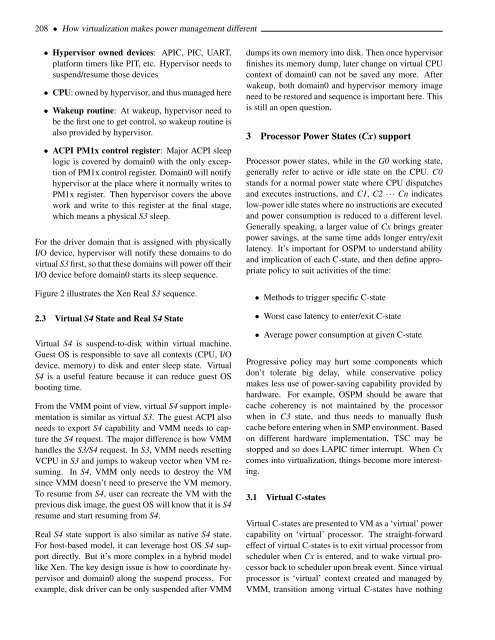How virtualization makes power management different
How virtualization makes power management different
How virtualization makes power management different
Create successful ePaper yourself
Turn your PDF publications into a flip-book with our unique Google optimized e-Paper software.
208 • <strong>How</strong> <strong>virtualization</strong> <strong>makes</strong> <strong>power</strong> <strong>management</strong> <strong>different</strong><br />
• Hypervisor owned devices: APIC, PIC, UART,<br />
platform timers like PIT, etc. Hypervisor needs to<br />
suspend/resume those devices<br />
• CPU: owned by hypervisor, and thus managed here<br />
• Wakeup routine: At wakeup, hypervisor need to<br />
be the first one to get control, so wakeup routine is<br />
also provided by hypervisor.<br />
• ACPI PM1x control register: Major ACPI sleep<br />
logic is covered by domain0 with the only exception<br />
of PM1x control register. Domain0 will notify<br />
hypervisor at the place where it normally writes to<br />
PM1x register. Then hypervisor covers the above<br />
work and write to this register at the final stage,<br />
which means a physical S3 sleep.<br />
For the driver domain that is assigned with physically<br />
I/O device, hypervisor will notify these domains to do<br />
virtual S3 first, so that these domains will <strong>power</strong> off their<br />
I/O device before domain0 starts its sleep sequence.<br />
Figure 2 illustrates the Xen Real S3 sequence.<br />
2.3 Virtual S4 State and Real S4 State<br />
Virtual S4 is suspend-to-disk within virtual machine.<br />
Guest OS is responsible to save all contexts (CPU, I/O<br />
device, memory) to disk and enter sleep state. Virtual<br />
S4 is a useful feature because it can reduce guest OS<br />
booting time.<br />
From the VMM point of view, virtual S4 support implementation<br />
is similar as virtual S3. The guest ACPI also<br />
needs to export S4 capability and VMM needs to capture<br />
the S4 request. The major difference is how VMM<br />
handles the S3/S4 request. In S3, VMM needs resetting<br />
VCPU in S3 and jumps to wakeup vector when VM resuming.<br />
In S4, VMM only needs to destroy the VM<br />
since VMM doesn’t need to preserve the VM memory.<br />
To resume from S4, user can recreate the VM with the<br />
previous disk image, the guest OS will know that it is S4<br />
resume and start resuming from S4.<br />
Real S4 state support is also similar as native S4 state.<br />
For host-based model, it can leverage host OS S4 support<br />
directly. But it’s more complex in a hybrid model<br />
like Xen. The key design issue is how to coordinate hypervisor<br />
and domain0 along the suspend process. For<br />
example, disk driver can be only suspended after VMM<br />
dumps its own memory into disk. Then once hypervisor<br />
finishes its memory dump, later change on virtual CPU<br />
context of domain0 can not be saved any more. After<br />
wakeup, both domain0 and hypervisor memory image<br />
need to be restored and sequence is important here. This<br />
is still an open question.<br />
3 Processor Power States (Cx) support<br />
Processor <strong>power</strong> states, while in the G0 working state,<br />
generally refer to active or idle state on the CPU. C0<br />
stands for a normal <strong>power</strong> state where CPU dispatches<br />
and executes instructions, and C1, C2 ··· Cn indicates<br />
low-<strong>power</strong> idle states where no instructions are executed<br />
and <strong>power</strong> consumption is reduced to a <strong>different</strong> level.<br />
Generally speaking, a larger value of Cx brings greater<br />
<strong>power</strong> savings, at the same time adds longer entry/exit<br />
latency. It’s important for OSPM to understand ability<br />
and implication of each C-state, and then define appropriate<br />
policy to suit activities of the time:<br />
• Methods to trigger specific C-state<br />
• Worst case latency to enter/exit C-state<br />
• Average <strong>power</strong> consumption at given C-state<br />
Progressive policy may hurt some components which<br />
don’t tolerate big delay, while conservative policy<br />
<strong>makes</strong> less use of <strong>power</strong>-saving capability provided by<br />
hardware. For example, OSPM should be aware that<br />
cache coherency is not maintained by the processor<br />
when in C3 state, and thus needs to manually flush<br />
cache before entering when in SMP environment. Based<br />
on <strong>different</strong> hardware implementation, TSC may be<br />
stopped and so does LAPIC timer interrupt. When Cx<br />
comes into <strong>virtualization</strong>, things become more interesting.<br />
3.1 Virtual C-states<br />
Virtual C-states are presented to VM as a ‘virtual’ <strong>power</strong><br />
capability on ‘virtual’ processor. The straight-forward<br />
effect of virtual C-states is to exit virtual processor from<br />
scheduler when Cx is entered, and to wake virtual processor<br />
back to scheduler upon break event. Since virtual<br />
processor is ‘virtual’ context created and managed by<br />
VMM, transition among virtual C-states have nothing

















